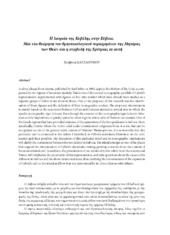| dc.contributor.author | Katsaounou, Silvana | |
| dc.date.accessioned | 2020-10-26T12:59:23Z | |
| dc.date.available | 2020-10-26T12:59:23Z | |
| dc.date.issued | 2017 | |
| dc.identifier.isbn | 978-960-85145-6-0 | |
| dc.identifier.issn | 2459-3230 | |
| dc.identifier.uri | https://hdl.handle.net/1956/24192 | |
| dc.description.abstract | A silver plaque from Eretria, published by Karl Reber in 1983, depicts the Mother of the Gods accompanied by two figures of uncertain identity. This is one of the several iconographic parallels of Cybele’s representation supplemented with figures on her Attic naiskoi which have already been studied as a separate group of reliefs in my doctoral thesis. One of the purposes of this research was the identification of those figures and the definition of their iconographic context. The proposed interpretation is mainly based on the syncretism between Cybele and Demeter attested at several sites in which the specific iconographic type is found. Even though the creation of this iconographic type is due to Athenian artistic inspirations, it quickly spread to other regions where cults of Demeter are attested. One of the Greek regions that have provided evidence of the syncretism of the two goddesses is Euboea. More specifically, Eretria, where the votive relief under consideration originates from, is a site that can be recognized as one of the greatest cultic centers of Demeter Thesmophoros. It is noteworthy that this particular cult is connected to the deities I identified on Cybele’s attendants illustrated on the Attic naiskoi and their parallels. My discussion of this particular relief and its iconographic implications will clarify the connections between the two deities in Euboea. The island emerges as one of the places that support the interpretation of Cybele’s attendants creating growing concerns about the content of the most debated cult. In addition, the presentation of two identical votive reliefs from Macedonia and Thrace will emphasize the peculiarity of this representation, and raise questions about the causes of its diffusion in Euboea and the above mentioned areas, thus clarifying the circumstances of the expansion of Cybele’s cult on the island and how that was determined by its close relations with Athens. | nob |
| dc.language.iso | ell | nob |
| dc.publisher | Norwegian Institute at Athens | nob |
| dc.relation.ispartofseries | Papers and Monographs from the Norwegian Institute at Athens | nob |
| dc.subject | Euboea Island - Archaeology | |
| dc.subject | Euboea Island - Religion | |
| dc.title | Η λατρεία της Κυβέλης στην Εύβοια. Μια νέα θεώρηση του θρησκειολογικού περιεχομένου της Μητέρας των Θεών και η συμβολή της Ερέτριας σε αυτή. | nob |
| dc.type | Chapter | nob |
